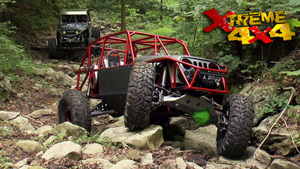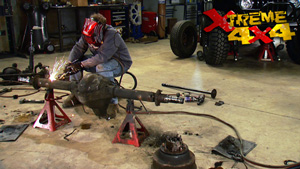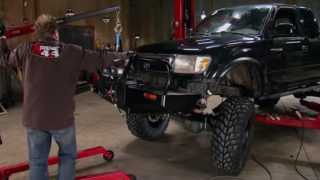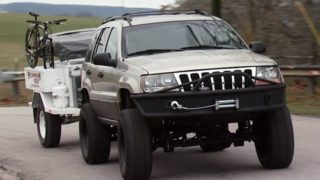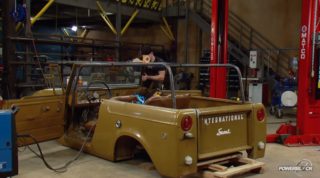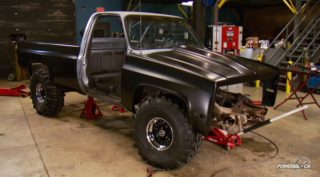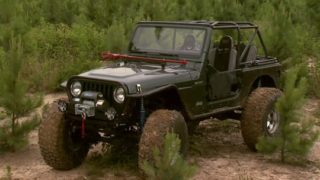More Budget TJ Episodes
Xtreme 4x4 Builds
Want more content like this?
Join the PowerNation Email NewsletterParts Used In This Episode
Allied Wheels
Raceline 17 x 9.5 8 lug RT231 Competition Beadlock Series Monster Black
Ballistic Fabrication
Tubing Adapters
Gen Right Off Road
Factory Seat Belt Mounting Kit
Gen Right Off Road
Swing Down Tube Style Tire Carrier
Gen Right Off Road
Weld-In Roll Cage Kit
JB Conversions
NP231 Partial Master Rebuild Kit
JB Conversions
NP231J HD Super Short Slip Yoke Eliminator
JB Conversions
Six Pinion Planetary Gearset
JB Conversions
Wide Chain and Sprocket Kit
MasterCraft Safety
Baja RS Performance Seats
MasterCraft Safety
Rear Rubicon Bench Seat
MasterCraft Safety
TJ Seat Mounting Brackets
Maxxis International
40 X 13.50 - 17 Maxxis M8090 Creepy Crawler
PSC Motorsports
Derale 12" Heat Sink Cooler Kit
PSC Motorsports
Jeep 95-02 TJ/XJ Extreme Duty Cylinder Assist Kit
Rod End Supply
3/4" Bearing Rod End
Warn Industries
Endurance 12.0 Winch
Episode Transcript
You've seen us design cut Bend Notch weld and grind and in the end fab up a roll cage that could save a life today on Xtreme four by four, we're gonna save you time with a pre cut pre bend cage. That's just as safe, but only takes a few hours to install. Plus more easy upgrades. That'll give your friends J
Envy.
Today. We've got our Jeep TJ back in the shop. If you guys remember, we're building this truck to be a good daily driver and weekend wheeler that you can still hit some seriously hardcore trails with. So we're not holding back with any hardcore parts, but we still want to make it very street
so you could still use it every day. Now, although this whole truck may seem like one great big project. If you break it down into each
individual project, you could easily knock them out with a couple of buddies in one weekend's time. Take, for example, our high line fender kit, you could drive the truck Monday to Friday, roll into the shop and just install the fenders and the corner guard
and then be back driving to work again. On Monday, a couple weeks later, you could roll it back in the shop and put the suspension kit on and then be back driving it again every day, back and forth
work. You can even completely rebuild these one ton axles that we did earlier and have them sitting in your shop ready to swap in. Just call up your friends, order some pizza, get some beverages and you can put them in in one weekend's time. Never sacrificing the ability to drive your truck back and forth to work every single day. And what we're gonna do today is a couple more small little jobs like that. We're gonna start with the transfer case.
Now, normally here at extreme, we'll be taking a transfer case out of a project to replace it with a crate or aftermarket unit, but we don't need to do that. In this case, our daily driver, weekend wheeler will work fine with this factory 231 if we make a couple changes. Now, the first thing we're gonna be addressing is the rear output from the factory. The Jeep 231 is a slip Yoke style output. That means the drive shaft simply slides onto the back of the transfer case. And the downfall with that is when your rear axle are
calculates out or droops out. When you're trail riding, the drive shaft can actually slide completely off the back of the transfer case and you become disconnected at the drive line. So to solve that, we're gonna be installing one of JB conversion's super short slip Yoke Eliminators. Now, not only does this convert the rear output over to a fixed joke style, but it also shortens up the total drive train link that'll give us a better angle on our rear drive shaft. Now, the nice thing with the 231 is it actually came as factory equipment inside a lot of half ton pickup trucks. It was called a 241. A lot of the upgrades that they put in the 241 will fit inside this 231 case, all that's available from JB conversions. And we're gonna be installing a heavy duty planetary gear set, new gears as well as their wider heavier duty chain that became available in a lot of dodge half ton pickup trucks. These upgrades along with the slip oak Eliminator and the fact that we're sticking with our stock 4 L means that this 231 will have a great life in our jeep.
The first step is to completely disassemble the transfer case
and we'll clean everything in the parts washer.
You want to remove all the silicone from the transfer case mating surfaces
and we'll start with the upgraded planetary.
The extra three pinions will distribute the low range load over a larger tooth area.
The wider chain requires a new gear to be slid onto the output shaft
as well as a new front output shaft,
then the new rear output housing is assembled onto the case
and it's reinstalled into the jeep.
Now, while the skid plates off the jeep, this is a great time to take care of our exhaust. Now, if you remember, we had to cut it off the truck to make room for our new front for
length and we ditched all the factory stuff to replace it with a complete magna flow exhaust system in order to get around our rear for
length. And we're going to be using some parts from a universal hot rod kit as well as one of their small compact aftermarket catalytic converters. They
just make it a lot easier to package everything underneath the Jeep and get around our suspension.
A ball flange will make the exhaust removable from the Jeep in two pieces
and a full polished stainless flow through muffler will not only sound great, it won't limit the power of our 4 L.
Later. Our fuel saving street truck returns for more tips on saving fuel on the street. Did you get that?
Plus Diy roll cage, steering seat belts and more
today, we've got our TJ back in the shop knocking out a bunch of little odds and ends, you know, projects you could easily do yourself in one weekend, drive the truck back and forth to work all week, pull in the shop, throw some parts at it and get it back on the road. On Monday. Perfect example of one of those projects is a steering upgrade. If you swapped out the larger wheels and tires like we've done with these 40 inch tall tires, you definitely wanna think about a hydraulic ram assist steering. Now, we a complete kit here all from PSC motor sports and it starts with a brand new steering gear. Now, this will still give us a mechanical linkage from the steering wheel down to the front axle, but it will help improve our steering through these two tapped ports on the side of the box. Now, these will deliver hydraulic fluid down to the ram that we mount on the axle. Now, this is simply a small hydraulic cylinder and when the fluid leaves the box and travels down to the,
it basically helps turn the tires when you turn the wheel. Now, that's a big help when you're sitting at a stop sign, dry, turning the tires. But more importantly, when you're out on the trail and your tires are bound up, there's enough assist in this ramp to help get you out of that jam and back on the trail. Now, when you do a ram assist, steering, it's not just a box and a ram, there's a couple other parts you're going to need.
The first is a brand new pump. Now, this is another unit that we got from
and it specifically spec to replace the pump on our 4 L in our Jeep with a brand new pulley that size to match our crank pulley on the engine. And more importantly, we also have a cooler. Now, what this extruded aluminum cooler will do is as the fluid is heading back to the box will pass through here and the heat will dissipate through these, these fins on the outside of the cooler that will drop the temperature of the fluid and extend life of all of our parts. So they don't get overheated. But more importantly, when you're out on the trail and you're using the steering a lot, what can happen is the fluid can heat up and it can start to cavit or get bubbles in it. It can cavit so much. It'll actually overflow out the top of your reservoir using a cooler will keep the temperature of the fluid down. You'll be able to use the steering a lot more when you're out on the trail, not worry about it. Overheating, extend the life of your parts. It's just good insurance for your truck
first, we will remove the old steering box from the frame
and install the new PSC unit.
Swapping the old pitman arm over from the old box.
A new steering system has to be built using dom tubing
and adapters from ballistic fabrication.
New chrome moly rod ends from rod end supply will allow for more articulation in our steering system
with the axle turned all the way to the right. The ram is positioned on to the axle and then tacked to the tie
rod
and the steering is cycled to check for clearance.
The pump is a direct replacement for the stocks, 4 L pumps and it bolts up using the original bracket.
The fluid reservoir needs to be as close to the pump as possible.
And the feed tube to the pump should not have any kinks or sharp turns in it.
Finally, we will make all of the hydraulic lines
and hook up the cooler to the return line heading back to the reservoir.
Then we'll fill up a system with some royal purple max E steering fluid
and test for leaks.
A common mistake when installing a hydraulic ram assist kit like this is inverting the lines as they come out of the steering box. Now, what that means is when you turn the steering wheel to the right, the diverted hydraulic fluid is going to use the ra M to try to pull them to the left. Now, best case scenario, the steering wheel won't turn. Worst case scenario. If you have enough pressure, you can actually bend the drag link in your steering system because that hydraulic ram is almost like a tubing bender that's been bolted onto your front axle. Now, you want to test for that by doing what we did here. I unbolted the ramp. We're gonna simply start the truck, turn the wheels all the way to the right and we should see the ramp fully extend.
Now, in our case, we're in good shape. If we weren't, I just have to swap those lines side to side,
hook it all back up, test it again.
Now, if you don't have a lot of time on your hands, but you still want a full roll cage inside your rig. The best option is to go ahead and get a kit. Now, a lot of different manufacturers make them for most popular models and ours for our Jeep TJ came from Gen right off road. It has all the tubes, pre
bent and pre notch to replace our factory roll cage with one that's meant for some hardcore wheeling. While we're at it, we're gonna replace our worn out stock seats with some suspension seats that we got from Mastercraft. Now, this is a master craft
ha ha
Rs and it has the standard suspension seat benefits to basically take the shock at a wheeling. But the best thing in our case is the fact that it's a recliner that we can adjust how we sit. And since our cage does not limit the access to the back seat, the recliner also has the feature to spring forward to make it easier to climb into the back. So you're not having to climb over the side of the Jeep due to a fixed back suspension seat. Now in the back, we'll just swap out the bench with this full suspension bench that will bolt into the stock location. And all we have to do now is get to work
before the new cage goes in.
The old stock, one's gotta come out.
We'll begin with the B pillar uprights.
Then the rear kickers sit on four plates included in the kit.
The center roof spreader sets the width of the cage
and now it's time for the front dash plates.
Instructions provided with the kit, say the front roof bar is next.
Then the rear roof bar
and the filler tubes.
After making sure the cage is level and square,
it's completely welded in,
then we'll wipe it down
and give it a coat of rattle can black paint
Mastercraft provides direct bolt in brackets for the seats to use the factory mounts
and the rear bench bolts to existing holes in the floor.
Now, if we're building a hardcore trail, Jeep, we definitely want to make provisions in this roll cage to install this four point harness system to go with our suspension seats. But because we don't have a belt bar that's running across the center of this cage, we would not have proper mounting locations for these shoulder straps. We'd really be limited to mounting them down on the floor and that is not where you want to mount them. You want them just below your shoulder height in the seat. And since this thing is a dual purpose, Jeep, we're gonna go ahead and stick with the three point harnesses from the factory. Now, the nice thing about this cage we got from generate, come with these little brackets so we can simply weld into the bottom of the cage and reinstall the factory retractor assemblies and then we'll just throw bolt, the upper pivot and we have the connectors hooked up to the factory seat mounts.
Ok.
Out
C
A quick and easy job. That'll give you more confidence when you're out wheeling and change. The look of your truck is to install a full size fare onto a tire carrier. It'll give you that more confidence because when you're out in the woods and you're crawling over some rocks, you won't be worried so much about cutting the side wall of a tire or possibly
imaging a rim because you'll have a full size replacement bolted to the back of your rig.
Now, we've already gone ahead and installed a tire carrier on the back of our TJ from gen right off road and to finish this job, all we have to do is mount up this maxis 40 inch tall tire onto this 17 inch aluminum allied monster bead lock.
Nice.
You're watching Xtreme 4x4 for a DVD copy of this episode. Just go to Power Block tv.com and order your copy for just 595 plus shipping and handling. Start your own Xtreme 4x4 collection delivered right to your door from the power block
today. At extreme, we've been taking you guys through a bunch of little projects that you could easily knock out about a weekend's worth of time and make your truck way better off road. We've installed a slippy oak Eliminator hydraulic ram assist and a brand new roll cage. But nothing's gonna save your neck more when you're out in the woods than a good winch bolted to the front bumper of your rake. Now, a good rule of thumb, let's take the size of your
and double the weight and that gives you the minimum size of winch, but it's never wrong to go over that. We're going to be installing a 12,000 pound worn endurance series winch on the front of our Jeep, it comes pre spooled with all the aircraft cable and it can handle a 12,000 pound single line pull. Now, the term endurance refers to the electric motor. Now, you can run that motor a lot longer, so you have longer line poles. Thanks to this small fan that you mount under the hood that force cools the motor by forcing air into one end and allowing it to exhaust the other cooling. That electric motor will keep it from overheating and that overheating can cause the winch to shut down when you're halfway through a long pole. All we have to do now is bolt this winch to our new bumper.
We'll remove the bumper from the front of our Jeep to access the Winch Mountain balls.
Once it's fastened down, we'll slide the bumper back on the frame rails
and bolt it in place.
And all we have to do is hook up the main power feeds to our battery.
Now, we finished a bunch of stuff on our Jeep TJ today. But right now we're gonna slide that truck aside and bring in our weekend wheeler daily driver fuel saving street truck.
If you remember, we've got a 1996 1500 series dodge that we're chasing down better fuel economy. And at the same time, we want to toughen it up so we can take it off road on the weekends. Now. So far, we've improved it a little bit. We got it to almost 10
MPG right now. We're going to make a serious investment to get it better off road and save a little bit more money at the pump and it's going to start by swapping out the axles both front and rear. Now, these are Dana sixties from a 1998 dodge three quarter ton. Now, the nice thing about these is they're a lot stronger than the stock axles that come in the 1500. But more importantly, the gear ratio in them is different. Now, that's going to compensate
for the larger wheels and tires that are on the truck. Now, that's a serious investment. It's about 1000 bucks, but at the same time, it's gonna make the truck stronger and it's gonna make it a little bit better on fuel because of that gear ratio difference. Now, we are gonna have to change out the wheels and tires because the day in the sixties have an eight lug. So we need to put an eight lug wheel and tire on there and we're gonna take advantage of needing to do that because that is we're gonna save the majority of our gas mileage.
Now by no means, are we telling you guys, do you wanna save a little bit of money on gas? Run out, buy new wheels and tires. That's kinda like stepping over dollars to pick up dimes. What we are saying is that when it's time to buy some tires, whether yours are worn out like this truck here or you're gonna change them because you're changing the axles like we are as well. Be honest with yourself, don't buy the most aggressive off road tire because you think it looks cool. Get a good middle of the road tire like this Mickey Thompson Baha mtz. Now, the nice thing about this tire is the tread pattern is pretty close knit. Now, that means it's gonna have a very low rolling resistance when you're driving on the highway, that'll save you a little bit of gas because it's not as much power to turn the tire with the truck. Now, since we had to swap the rims out as well, we had them go ahead and install these tires on a set of their new
17 by nine side bitter aluminum wheel in that eight L pattern to match our new data, 60 axles. Now, all we have to do is pull the half ton axles out, bolt up the new three quarter ton units, no custom fab needed because they're out of the same model truck. Once we get the new tires and wheels on there, we'll run a couple of tanks worth of fuel through this truck. Let you know what kind of fuel economy numbers we get.
We're shooting for low thirteens.
Show Full Transcript
Envy.
Today. We've got our Jeep TJ back in the shop. If you guys remember, we're building this truck to be a good daily driver and weekend wheeler that you can still hit some seriously hardcore trails with. So we're not holding back with any hardcore parts, but we still want to make it very street
so you could still use it every day. Now, although this whole truck may seem like one great big project. If you break it down into each
individual project, you could easily knock them out with a couple of buddies in one weekend's time. Take, for example, our high line fender kit, you could drive the truck Monday to Friday, roll into the shop and just install the fenders and the corner guard
and then be back driving to work again. On Monday, a couple weeks later, you could roll it back in the shop and put the suspension kit on and then be back driving it again every day, back and forth
work. You can even completely rebuild these one ton axles that we did earlier and have them sitting in your shop ready to swap in. Just call up your friends, order some pizza, get some beverages and you can put them in in one weekend's time. Never sacrificing the ability to drive your truck back and forth to work every single day. And what we're gonna do today is a couple more small little jobs like that. We're gonna start with the transfer case.
Now, normally here at extreme, we'll be taking a transfer case out of a project to replace it with a crate or aftermarket unit, but we don't need to do that. In this case, our daily driver, weekend wheeler will work fine with this factory 231 if we make a couple changes. Now, the first thing we're gonna be addressing is the rear output from the factory. The Jeep 231 is a slip Yoke style output. That means the drive shaft simply slides onto the back of the transfer case. And the downfall with that is when your rear axle are
calculates out or droops out. When you're trail riding, the drive shaft can actually slide completely off the back of the transfer case and you become disconnected at the drive line. So to solve that, we're gonna be installing one of JB conversion's super short slip Yoke Eliminators. Now, not only does this convert the rear output over to a fixed joke style, but it also shortens up the total drive train link that'll give us a better angle on our rear drive shaft. Now, the nice thing with the 231 is it actually came as factory equipment inside a lot of half ton pickup trucks. It was called a 241. A lot of the upgrades that they put in the 241 will fit inside this 231 case, all that's available from JB conversions. And we're gonna be installing a heavy duty planetary gear set, new gears as well as their wider heavier duty chain that became available in a lot of dodge half ton pickup trucks. These upgrades along with the slip oak Eliminator and the fact that we're sticking with our stock 4 L means that this 231 will have a great life in our jeep.
The first step is to completely disassemble the transfer case
and we'll clean everything in the parts washer.
You want to remove all the silicone from the transfer case mating surfaces
and we'll start with the upgraded planetary.
The extra three pinions will distribute the low range load over a larger tooth area.
The wider chain requires a new gear to be slid onto the output shaft
as well as a new front output shaft,
then the new rear output housing is assembled onto the case
and it's reinstalled into the jeep.
Now, while the skid plates off the jeep, this is a great time to take care of our exhaust. Now, if you remember, we had to cut it off the truck to make room for our new front for
length and we ditched all the factory stuff to replace it with a complete magna flow exhaust system in order to get around our rear for
length. And we're going to be using some parts from a universal hot rod kit as well as one of their small compact aftermarket catalytic converters. They
just make it a lot easier to package everything underneath the Jeep and get around our suspension.
A ball flange will make the exhaust removable from the Jeep in two pieces
and a full polished stainless flow through muffler will not only sound great, it won't limit the power of our 4 L.
Later. Our fuel saving street truck returns for more tips on saving fuel on the street. Did you get that?
Plus Diy roll cage, steering seat belts and more
today, we've got our TJ back in the shop knocking out a bunch of little odds and ends, you know, projects you could easily do yourself in one weekend, drive the truck back and forth to work all week, pull in the shop, throw some parts at it and get it back on the road. On Monday. Perfect example of one of those projects is a steering upgrade. If you swapped out the larger wheels and tires like we've done with these 40 inch tall tires, you definitely wanna think about a hydraulic ram assist steering. Now, we a complete kit here all from PSC motor sports and it starts with a brand new steering gear. Now, this will still give us a mechanical linkage from the steering wheel down to the front axle, but it will help improve our steering through these two tapped ports on the side of the box. Now, these will deliver hydraulic fluid down to the ram that we mount on the axle. Now, this is simply a small hydraulic cylinder and when the fluid leaves the box and travels down to the,
it basically helps turn the tires when you turn the wheel. Now, that's a big help when you're sitting at a stop sign, dry, turning the tires. But more importantly, when you're out on the trail and your tires are bound up, there's enough assist in this ramp to help get you out of that jam and back on the trail. Now, when you do a ram assist, steering, it's not just a box and a ram, there's a couple other parts you're going to need.
The first is a brand new pump. Now, this is another unit that we got from
and it specifically spec to replace the pump on our 4 L in our Jeep with a brand new pulley that size to match our crank pulley on the engine. And more importantly, we also have a cooler. Now, what this extruded aluminum cooler will do is as the fluid is heading back to the box will pass through here and the heat will dissipate through these, these fins on the outside of the cooler that will drop the temperature of the fluid and extend life of all of our parts. So they don't get overheated. But more importantly, when you're out on the trail and you're using the steering a lot, what can happen is the fluid can heat up and it can start to cavit or get bubbles in it. It can cavit so much. It'll actually overflow out the top of your reservoir using a cooler will keep the temperature of the fluid down. You'll be able to use the steering a lot more when you're out on the trail, not worry about it. Overheating, extend the life of your parts. It's just good insurance for your truck
first, we will remove the old steering box from the frame
and install the new PSC unit.
Swapping the old pitman arm over from the old box.
A new steering system has to be built using dom tubing
and adapters from ballistic fabrication.
New chrome moly rod ends from rod end supply will allow for more articulation in our steering system
with the axle turned all the way to the right. The ram is positioned on to the axle and then tacked to the tie
rod
and the steering is cycled to check for clearance.
The pump is a direct replacement for the stocks, 4 L pumps and it bolts up using the original bracket.
The fluid reservoir needs to be as close to the pump as possible.
And the feed tube to the pump should not have any kinks or sharp turns in it.
Finally, we will make all of the hydraulic lines
and hook up the cooler to the return line heading back to the reservoir.
Then we'll fill up a system with some royal purple max E steering fluid
and test for leaks.
A common mistake when installing a hydraulic ram assist kit like this is inverting the lines as they come out of the steering box. Now, what that means is when you turn the steering wheel to the right, the diverted hydraulic fluid is going to use the ra M to try to pull them to the left. Now, best case scenario, the steering wheel won't turn. Worst case scenario. If you have enough pressure, you can actually bend the drag link in your steering system because that hydraulic ram is almost like a tubing bender that's been bolted onto your front axle. Now, you want to test for that by doing what we did here. I unbolted the ramp. We're gonna simply start the truck, turn the wheels all the way to the right and we should see the ramp fully extend.
Now, in our case, we're in good shape. If we weren't, I just have to swap those lines side to side,
hook it all back up, test it again.
Now, if you don't have a lot of time on your hands, but you still want a full roll cage inside your rig. The best option is to go ahead and get a kit. Now, a lot of different manufacturers make them for most popular models and ours for our Jeep TJ came from Gen right off road. It has all the tubes, pre
bent and pre notch to replace our factory roll cage with one that's meant for some hardcore wheeling. While we're at it, we're gonna replace our worn out stock seats with some suspension seats that we got from Mastercraft. Now, this is a master craft
ha ha
Rs and it has the standard suspension seat benefits to basically take the shock at a wheeling. But the best thing in our case is the fact that it's a recliner that we can adjust how we sit. And since our cage does not limit the access to the back seat, the recliner also has the feature to spring forward to make it easier to climb into the back. So you're not having to climb over the side of the Jeep due to a fixed back suspension seat. Now in the back, we'll just swap out the bench with this full suspension bench that will bolt into the stock location. And all we have to do now is get to work
before the new cage goes in.
The old stock, one's gotta come out.
We'll begin with the B pillar uprights.
Then the rear kickers sit on four plates included in the kit.
The center roof spreader sets the width of the cage
and now it's time for the front dash plates.
Instructions provided with the kit, say the front roof bar is next.
Then the rear roof bar
and the filler tubes.
After making sure the cage is level and square,
it's completely welded in,
then we'll wipe it down
and give it a coat of rattle can black paint
Mastercraft provides direct bolt in brackets for the seats to use the factory mounts
and the rear bench bolts to existing holes in the floor.
Now, if we're building a hardcore trail, Jeep, we definitely want to make provisions in this roll cage to install this four point harness system to go with our suspension seats. But because we don't have a belt bar that's running across the center of this cage, we would not have proper mounting locations for these shoulder straps. We'd really be limited to mounting them down on the floor and that is not where you want to mount them. You want them just below your shoulder height in the seat. And since this thing is a dual purpose, Jeep, we're gonna go ahead and stick with the three point harnesses from the factory. Now, the nice thing about this cage we got from generate, come with these little brackets so we can simply weld into the bottom of the cage and reinstall the factory retractor assemblies and then we'll just throw bolt, the upper pivot and we have the connectors hooked up to the factory seat mounts.
Ok.
Out
C
A quick and easy job. That'll give you more confidence when you're out wheeling and change. The look of your truck is to install a full size fare onto a tire carrier. It'll give you that more confidence because when you're out in the woods and you're crawling over some rocks, you won't be worried so much about cutting the side wall of a tire or possibly
imaging a rim because you'll have a full size replacement bolted to the back of your rig.
Now, we've already gone ahead and installed a tire carrier on the back of our TJ from gen right off road and to finish this job, all we have to do is mount up this maxis 40 inch tall tire onto this 17 inch aluminum allied monster bead lock.
Nice.
You're watching Xtreme 4x4 for a DVD copy of this episode. Just go to Power Block tv.com and order your copy for just 595 plus shipping and handling. Start your own Xtreme 4x4 collection delivered right to your door from the power block
today. At extreme, we've been taking you guys through a bunch of little projects that you could easily knock out about a weekend's worth of time and make your truck way better off road. We've installed a slippy oak Eliminator hydraulic ram assist and a brand new roll cage. But nothing's gonna save your neck more when you're out in the woods than a good winch bolted to the front bumper of your rake. Now, a good rule of thumb, let's take the size of your
and double the weight and that gives you the minimum size of winch, but it's never wrong to go over that. We're going to be installing a 12,000 pound worn endurance series winch on the front of our Jeep, it comes pre spooled with all the aircraft cable and it can handle a 12,000 pound single line pull. Now, the term endurance refers to the electric motor. Now, you can run that motor a lot longer, so you have longer line poles. Thanks to this small fan that you mount under the hood that force cools the motor by forcing air into one end and allowing it to exhaust the other cooling. That electric motor will keep it from overheating and that overheating can cause the winch to shut down when you're halfway through a long pole. All we have to do now is bolt this winch to our new bumper.
We'll remove the bumper from the front of our Jeep to access the Winch Mountain balls.
Once it's fastened down, we'll slide the bumper back on the frame rails
and bolt it in place.
And all we have to do is hook up the main power feeds to our battery.
Now, we finished a bunch of stuff on our Jeep TJ today. But right now we're gonna slide that truck aside and bring in our weekend wheeler daily driver fuel saving street truck.
If you remember, we've got a 1996 1500 series dodge that we're chasing down better fuel economy. And at the same time, we want to toughen it up so we can take it off road on the weekends. Now. So far, we've improved it a little bit. We got it to almost 10
MPG right now. We're going to make a serious investment to get it better off road and save a little bit more money at the pump and it's going to start by swapping out the axles both front and rear. Now, these are Dana sixties from a 1998 dodge three quarter ton. Now, the nice thing about these is they're a lot stronger than the stock axles that come in the 1500. But more importantly, the gear ratio in them is different. Now, that's going to compensate
for the larger wheels and tires that are on the truck. Now, that's a serious investment. It's about 1000 bucks, but at the same time, it's gonna make the truck stronger and it's gonna make it a little bit better on fuel because of that gear ratio difference. Now, we are gonna have to change out the wheels and tires because the day in the sixties have an eight lug. So we need to put an eight lug wheel and tire on there and we're gonna take advantage of needing to do that because that is we're gonna save the majority of our gas mileage.
Now by no means, are we telling you guys, do you wanna save a little bit of money on gas? Run out, buy new wheels and tires. That's kinda like stepping over dollars to pick up dimes. What we are saying is that when it's time to buy some tires, whether yours are worn out like this truck here or you're gonna change them because you're changing the axles like we are as well. Be honest with yourself, don't buy the most aggressive off road tire because you think it looks cool. Get a good middle of the road tire like this Mickey Thompson Baha mtz. Now, the nice thing about this tire is the tread pattern is pretty close knit. Now, that means it's gonna have a very low rolling resistance when you're driving on the highway, that'll save you a little bit of gas because it's not as much power to turn the tire with the truck. Now, since we had to swap the rims out as well, we had them go ahead and install these tires on a set of their new
17 by nine side bitter aluminum wheel in that eight L pattern to match our new data, 60 axles. Now, all we have to do is pull the half ton axles out, bolt up the new three quarter ton units, no custom fab needed because they're out of the same model truck. Once we get the new tires and wheels on there, we'll run a couple of tanks worth of fuel through this truck. Let you know what kind of fuel economy numbers we get.
We're shooting for low thirteens.







